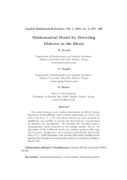| dc.contributor.author | Kwach, Boniface Otieno | |
| dc.contributor.author | Ongati, Omolo | |
| dc.contributor.author | Simwa, Richard | |
| dc.date.accessioned | 2019-04-26T08:08:12Z | |
| dc.date.available | 2019-04-26T08:08:12Z | |
| dc.date.issued | 2011-07-01 | |
| dc.identifier.uri | https://s3.amazonaws.com/academia.edu.documents/30898945/kwachAMS5-8-2011.pdf?AWSAccessKeyId=AKIAIWOWYYGZ2Y53UL3A&Expires=1556268653&Signature=hq0lCEnALo8cu1o0YucLuevod8E%3D&response-content-disposition=inline%3B%20filename%3DMathematical_Model_for_Detecting_Diabete.pdf | |
| dc.identifier.uri | http://erepository.kibu.ac.ke/handle/123456789/678 | |
| dc.description.abstract | This study presents a new mathematical model for Blood Glucose Regulatory System(BGRS) which includes epinephrine as a third variable in the form, Ў= AY, and whose solution has been analyzed for equilibrium and stability to provide the blood glucose concentrations for diabetics and non-diabetics. We establish that the final model is asymptotically stable compared to the existing models, that is, the eigenvalues of the coefficient matrix are complex numbers with negative real parts. Furthermore, the resonance period for the final model, that is,
T0 = 2:9847134 hours, is far less than that of the existing model, showing that the glucose concentration returns to normal level within a shorter time. | en_US |
| dc.language.iso | en | en_US |
| dc.publisher | Academia | en_US |
| dc.rights | Attribution-NonCommercial-ShareAlike 3.0 United States | * |
| dc.rights.uri | http://creativecommons.org/licenses/by-nc-sa/3.0/us/ | * |
| dc.subject | Mathematical model | en_US |
| dc.subject | Linear system | en_US |
| dc.subject | Resonance period | en_US |
| dc.title | Mathematical model for detecting diabetes in the blood | en_US |
| dc.type | Article | en_US |

